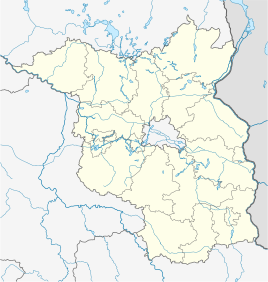Grano (Schenkendöbern)
|
Grano
Granow Community of Schenkendöbern
Coordinates: 51 ° 58 ′ 27 ″ N , 14 ° 37 ′ 46 ″ E
|
||
|---|---|---|
| Height : | 53 m above sea level NHN | |
| Residents : | 292 (2006) | |
| Incorporation : | December 31, 1998 | |
| Incorporated into: | Lutzketal | |
| Postal code : | 03172 | |
| Area code : | 035691 | |
|
Location of Grano in Brandenburg |
||
|
Grano village church (2016)
|
||
Grano , Granow in Lower Sorbian , is a district of the municipality of Schenkendöbern in the Spree-Neisse district in Brandenburg .
Geography and transport links
Grano is located in Lower Lusatia about seven kilometers west of Guben . Neighboring places are Lauschütz in the north, the Guben district of Bresinchen in the northeast, Groß Breesen in the east, which also belongs to Guben , the main town of Schenkendöbern with the residential area Wilschwitz in the south, Lübbinchen and Krayne in the west and Groß Drewitz in the northwest.
Grano is on the state road 46. The federal road 112 from Forst to Küstriner Vorland runs east through the district of Grano.
history
Grano was first mentioned in a document in 1346. The Lords of Bomsdorf owned the place until 1665 . In 1745 the Grano estate went into civil ownership. At that time, the place belonged as a vassal village to the estate of Forst .
The village church in Grano was rebuilt in 1854. In 1652 a water mill was built . A school was built in Grano in 1841 and the building now serves as a residential building. From 1948 the school was located in the former manor house. In the years 1981/82 a new school with a sports facility was built, which since the school year 1991/92 has housed a comprehensive school with an integrated elementary school .
Wine has been grown in Grano since 2004 .
After the Congress of Vienna , Niederlausitz and Grano came to the Kingdom of Prussia . There the place was in the administrative district of Grano in the district of Guben . On July 25, 1952, Grano was assigned to the newly formed Guben district in the Cottbus district and, after the fall of the Wall, was in the Guben district in Brandenburg . After the district reform in Brandenburg on December 6, 1993 , Grano came to the newly formed Spree-Neisse district . On December 31, 1998 Grano became part of the newly formed community Lutzketal , which was merged on October 26, 2003 with the previously independent communities of Atterwasch , Bärenklau , Gastrose-Kerkwitz , Grabko and Pinnow-Heideland to form the new community Schenkendöbern .
Population development
| Population development in Grano from 1875 to 1997 | |||||||||||||
|---|---|---|---|---|---|---|---|---|---|---|---|---|---|
| year | Residents | year | Residents | year | Residents | ||||||||
| 1875 | 221 | 1939 | 144 | 1981 | 167 | ||||||||
| 1890 | 185 | 1946 | 241 | 1985 | 174 | ||||||||
| 1910 | 197 | 1950 | 242 | 1989 | 173 | ||||||||
| 1925 | 195 | 1964 | 201 | 1992 | 176 | ||||||||
| 1933 | 187 | 1971 | 197 | 1997 | 264 | ||||||||
Attractions
Architectural monuments
In the list of architectural monuments in Schenkendöbern , two architectural monuments are listed for Grano :
- the village church (Kirchgasse 3), an elongated hall building with a west tower that barely towers over the gable roof of the church; Year of construction of the church 1799, extensive renovation in 1854
- the mansion (Schulweg 3)
Nature reserves
Grano west of the 544.75 extends ha large nature reserve Krayner Ponds / Lutzketal .
- (see also the list of nature reserves in Brandenburg )
Web links
proof
- ↑ a b c Granow village chronicle. In: schenkendoebern.de. Retrieved April 8, 2017 .
- ^ Grano in the database of the Verein für Computergenealogie. Retrieved April 8, 2017 .
- ↑ Historical municipality register of the state of Brandenburg 1875 to 2005. (PDF; 331 KB) District Spree-Neisse. State Office for Data Processing and Statistics State of Brandenburg, December 2006, accessed on April 8, 2017 .
- ↑ Krayner Teiche / Lutzketal (map) on protectedplanet.net

